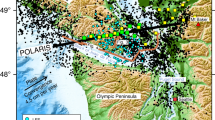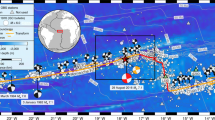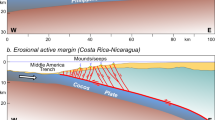Abstract
Temporal variations of the frictional resistance on subduction-zone plate boundary faults associated with the stick–slip cycle of large interplate earthquakes are thought to modulate the stress regime and earthquake activity within the subducting oceanic plate1,2,3. Here we report on two great earthquakes that occurred near the Kuril islands, which shed light on this process and demonstrate the enhanced seismic hazard accompanying triggered faulting. On 15 November 2006, an event of moment magnitude 8.3 ruptured the shallow-dipping plate boundary along which the Pacific plate descends beneath the central Kuril arc. The thrust ruptured a seismic gap that previously had uncertain seismogenic potential4,5, although the earlier occurrence of outer-rise compressional events had suggested the presence of frictional resistance1,2. Within minutes of this large underthrusting event, intraplate extensional earthquakes commenced in the outer rise region seaward of the Kuril trench, and on 13 January 2007, an event of moment magnitude 8.1 ruptured a normal fault extending through the upper portion of the Pacific plate, producing one of the largest recorded shallow extensional earthquakes. This energetic earthquake sequence demonstrates the stress transfer process within the subducting lithosphere, and the distinct rupture characteristics of these great earthquakes illuminate differences in seismogenic properties and seismic hazard of such interplate and intraplate faults.
This is a preview of subscription content, access via your institution
Access options
Subscribe to this journal
Receive 51 print issues and online access
$199.00 per year
only $3.90 per issue
Buy this article
- Purchase on Springer Link
- Instant access to full article PDF
Prices may be subject to local taxes which are calculated during checkout




Similar content being viewed by others
References
Christensen, D. H. & Ruff, L. J. Seismic coupling and outer rise earthquakes. J. Geophys. Res. 93, 13421–13444 (1988)
Lay, T., Astiz, L., Kanamori, H. & Christensen, D. H. Temporal variation of large intraplate earthquakes in coupled subduction zones. Phys. Earth Planet. Inter. 54, 258–312 (1989)
Dmowska, R., Rice, J. R., Lovison, L. C. & Josell, D. Stress transfer and seismi phenomena in coupled subduction zones during the earthquake cycle. J. Geophys. Res. 93, 7869–7884 (1988)
Lay, T., Kanamori, H. & Ruff, L. J. The asperity model and the nature of large subduction zone earthquakes. Earthquake Prediction Res. 1, 3–71 (1982)
McCann, W. R., Nishenko, S. P., Sykes, L. R. & Krasue, J. Seismic gaps and plate tectonics; seismic potential for major boundaries. Pure Appl. Geophys. 117, 1082–1147 (1979)
Lay, T. & Kanamori, H. Earthquake doublets in the Solomon Islands. Phys. Earth Planet. Inter. 21, 283–304 (1980)
Xu, Z. & Schwartz, S. Y. Large earthquake doublets and fault plane heterogeneity in the northern Solomon Islands subduction zone. Pure Appl. Geophys. 140, 365–390 (1993)
Kagan, Y. Y. & Jackson, D. D. Worldwide doublets of large shallow earthquakes. Bull. Seismol. Soc. Am. 89, 1147–1155 (1999)
Gibowicz, S. J. & Lasocki, S. Earthquake doublets and multiplets in the Fiji-Tonga-Kermadec region. Acta Geophys. Polon. 53, 239–274 (2005)
Nomanbhoy, N. & Ruff, L. J. A simple discrete element model for large multiplet earthquake. J. Geophys. Res. 101, 5707–5723 (1996)
Ammon, C. J. et al. Rupture process of the 2004 Sumatra-Andaman earthquake. Science 308, 1133–1139 (2005)
Ammon, C. J., Kanamori, H., Lay, T. & Velasco, A. A. The 17 July 2006 Java tsunami earthquake (Mw = 7.8). Geophys. Res. Lett. 33 L24308 10.10239/2006GL028005 (2006)
Ammon, C. J., Velasco, A. A. & Lay, T. Rapid determination of first-order rupture characteristics for large earthquakes using surface waves: the 2004 Sumatra-Andaman earthquake. Geophys. Res. Lett. 33 10.1029/2006GL026303 (2006)
Kanamori, H. Seismological evidence for a lithospheric normal faulting; the Sanriku earthquake of 1933. Phys. Earth Planet. Inter. 4, 289–300 (1971)
Venkataraman, A. & Kanamori, H. Observational constraints on the fracture energy of subduction zone earthquakes. J. Geophys. Res. 109 10.1029/2003JB002549 (2004)
Song, T. A. & Simons, M. Large trench-parallel gravity variations predict seismogenic behavior in subduction zones. Science 301, 630–633 (2003)
Wells, R. E., Blakely, R. J., Sugiyama, Y., Scholl, D. W. & Dinterman, P. A. Basin-centered asperities in great subduction zone earthquakes; a link between slip, subsidence, and subduction erosion? J. Geophys. Res. 108 2507 10.1029/2002JB002072 (2003)
Ranero, C. R., Phipps Morgan, J., McIntosh, K. & Reichert, C. Bending-related faulting and mantle serpentinization at the Middle American Trench. Nature 425, 367–373 (2003)
Ranero, C. R., Villaseñor, A., Phipps Morgan, J. & Weinrebe, W. Relationship between bend-faulting at trenches and intermediate-depth seismicity. Geochem. Geophys. Geosyst. 6, Q12002 (2005)
Lynnes, C. S. & Lay, T. Source process of the great 1977 Sumba earthquake. J. Geophys. Res. 93, 13407–13420 (1988)
Abe, K. Lithospheric normal faulting beneath the Aleutian Trench. Phys. Earth Planet. Inter. 5, 190–198 (1972)
Lin, J. & Stein, R. S. Stress triggering in thrust and subduction earthquakes and stress interaction between the southern San Andreas and nearby thrust and strike-slip faults. J. Geophys. Res. 109 B02303 10.1029/2003JB002607 (2004)
Liu, X. & McNally, K. C. Quantitative estimates of interplate coupling inferred from outer rise earthquakes. Pure Appl. Geophys. 140, 211–255 (1993)
Taylor, M. A. J., Zheng, G., Rice, J. R., Stuart, W. D. & Dmowska, R. Cyclic stressing and seismicity at strong coupled subduction zones. J. Geophys. Res. 101, 8363–8381 (1996)
Melosh, H. J. Nonlinear stress propagation in the Earth’s upper mantle. J. Geophys. Res. 81, 5621–5632 (1976)
Peacock, S. M. Are the lower planes of double seismic zones caused by serpentine dehydration in subducting oceanic mantle? Geology 29, 299–302 (2001)
Ranero, C. R. & Sallares, V. Geophysical evidence for hydration of the crust and mantle of the Nazca plate during bending at the north Chile trench. Geology 32, 549–552 (2004)
Hartzell, S. H. & Heaton, T. H. Inversion of strong ground motion and teleseismic waveform data for the fault rupture history of the 1979 Imperial Valley, California, earthquake. Bull. Seismol. Soc. Am. 73, 1153–1184 (1983)
Velasco, A. A., Ammon, C. J. & Beck, S. L. Broadband source modeling of the November 8, 1997 Tibet (Mw = 7.5) earthquake and its tectonic implications. J. Geophys. Res. 105, 28065–28080 (2000)
Ji, C., Wald, D. J. & Helmberger, D. V. Source description of the 1999 Hector Mine earthquake. Part II: Complexity of slip history. Bull. Seismol. Soc. Am. 92, 1192–1226 (2002)
Acknowledgements
This work made use of GMT and SAC software and Federation of Digital Seismic Networks (FDSN) seismic data. The Incorporated Research Institutions for Seismology (IRIS) Data Management System (DMS) was used to access the data. This work was supported by an NSF grant and a USGS Award.
Author Contributions All authors contributed equally to the analysis and preparation of this paper.
Author information
Authors and Affiliations
Corresponding author
Supplementary information
Supplementary Information
The file contains Supplementary Notes, Supplementary Table S1 and Supplementary Figures S1-S6 with Legends. (PDF 3421 kb)
Rights and permissions
About this article
Cite this article
Ammon, C., Kanamori, H. & Lay, T. A great earthquake doublet and seismic stress transfer cycle in the central Kuril islands. Nature 451, 561–565 (2008). https://doi.org/10.1038/nature06521
Received:
Accepted:
Issue Date:
DOI: https://doi.org/10.1038/nature06521
This article is cited by
-
Fast and slow intraplate ruptures during the 19 October 2020 magnitude 7.6 Shumagin earthquake
Nature Communications (2023)
-
Decoupled co-seismic deformation and stress changes during the 2021 (Mw 6.0, 6.4) North Bandar Abbas doublet earthquakes in Fin region, SE-syntaxis of Zagros, Iran: new insights into the tectonic deformation decoupling process
Environmental Earth Sciences (2023)
-
Assessing the role of absolute stress measurement and relative stress real-time monitoring for earthquake research
Arabian Journal of Geosciences (2022)
-
Tsunami hazard assessment in the South China Sea: A review of recent progress and research gaps
Science China Earth Sciences (2022)
-
Frequency dispersion amplifies tsunamis caused by outer-rise normal faults
Scientific Reports (2021)
Comments
By submitting a comment you agree to abide by our Terms and Community Guidelines. If you find something abusive or that does not comply with our terms or guidelines please flag it as inappropriate.



